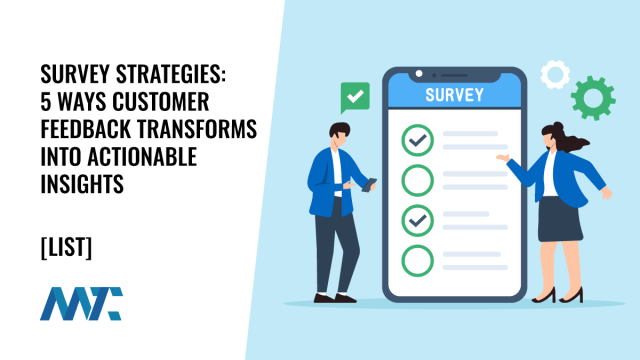Surveys have long been a staple of market research. Still, today they’re more than just a checkbox on a strategic to-do list—they’re one of the most powerful tools marketers, product teams, and customer experience leaders can use to gather real-time intelligence and drive informed decisions. As businesses increasingly rely on data to tailor their messaging, optimize offerings, and personalize customer journeys, online surveys have evolved from basic feedback tools into robust engines of continuous insight.
The rise of AI-powered analysis, improved user experience design, and multi-channel distribution methods has made surveys not only easier to deploy but more valuable in the insights they deliver. In this article, we’ll explore how to maximize the impact of surveys across your business strategy while incorporating today’s best practices and tools.
Table of Contents
Define and Refine Your AudienceTest Concepts and Messaging Before You LaunchClose the Loop with Feedback at Every StageDistribute Smartly and RespectfullyUse AI to Analyze at ScaleConclusion: A Culture of Listening Builds Loyalty
Define and Refine Your Audience
One of the most overlooked aspects of strategic planning is ensuring that your perception of your audience matches reality. Whether you’re launching a new product or refining a message, you need to know who you’re talking to—and more importantly, who’s listening.
Audience profiling through demographic and psychographic surveys is the first critical step. Go beyond surface-level attributes, such as age and gender. Consider behavioral drivers, lifestyle preferences, brand affinities, and media consumption habits. Tools make it easy to customize question paths based on logic branching, ensuring your surveys adapt dynamically to each respondent.
Ask questions such as:
What motivated your most recent purchase?
How do you typically discover new brands or products?
What platforms do you trust most for reviews or recommendations?
By analyzing the overlap between who you think your customer is and who they actually are, you can adjust your targeting, creative strategy, and product positioning accordingly.
Test Concepts and Messaging Before You Launch
Before investing in design, production, or development, it’s wise to validate your idea with real users. Concept testing enables you to understand potential appeal, highlight confusion or misalignment, and even prevent costly missteps.
Modern concept tests can include:
Image or branding comparisons: Upload mockups and let users vote on what’s most memorable or emotionally resonant.
Messaging or tagline tests: Present short copy blocks and ask respondents which resonates most and why.
Prototype walkthroughs: For apps or digital experiences, embed clickable prototypes using tools like Maze or PlaybookUX and ask targeted follow-up questions about usability.
Using Likert scales, open-text responses, and click heatmaps, you can delve deeper than surface-level preferences and uncover the underlying reasons behind consumer sentiment. Consider segmenting responses by persona to uncover which concepts resonate most with each audience segment—insights that are crucial for both marketing and product development.
Close the Loop with Feedback at Every Stage
Surveys aren’t just for pre-launch activities. The most successful brands build feedback loops into every stage of the customer lifecycle. Whether it’s post-purchase NPS surveys, onboarding experience feedback, or quarterly product satisfaction check-ins, listening consistently shows your audience that their voice matters—and provides your team with a constant flow of optimization data.
Key feedback types include:
Transactional Surveys: Triggered after specific actions (e.g., purchases, support calls) to capture contextual sentiment.
Relationship Surveys: Sent at regular intervals to track overall brand perception or customer satisfaction (CSAT, NPS).
Churn and Win-Back Surveys: Sent when a user downgrades, cancels, or lapses, helping you understand pain points and future opportunities.
To maximize the benefits of ongoing feedback, integrate your survey platforms with your CRM or CDP. This allows you to tie feedback directly to user profiles and automate follow-ups or workflows based on sentiment scores.
Distribute Smartly and Respectfully
Getting quality survey data requires thoughtful distribution. Avoid sending surveys at inconvenient times or to over-surveyed segments. Use A/B testing to optimize subject lines, utilize mobile-optimized formats, and ensure the value of participation is clear (what the feedback will improve and how participants will benefit).
Also consider:
Embedding surveys in-app or on-site for contextually triggered feedback
Using SMS or WhatsApp surveys for mobile-first audiences
Incentivizing completion with discounts, early access, or giveaways—just be transparent about how data will be used
Respect for privacy is essential. Always comply with GDPR, CCPA, and other relevant data regulations, and refrain from collecting unnecessary personal data without a clear rationale.
Use AI to Analyze at Scale
Modern survey platforms are increasingly incorporating AI and natural language processing (NLP) to analyze open-text responses, cluster sentiment, and surface key themes. This is particularly valuable when you collect thousands of responses across multiple cohorts.
Look for:
Topic modeling: Grouping responses around common themes
Sentiment analysis: Gauging emotional tone across responses
Anomaly detection: Spotting outlier feedback that may indicate a deeper issue
AI-powered tools can help distill rich qualitative feedback into actionable insights more quickly than manual review alone.
Conclusion: A Culture of Listening Builds Loyalty
Surveys, when done right, are not just tools for market research—they’re instruments of trust. When customers feel heard, and when their feedback leads to tangible improvements, loyalty and advocacy grow.
The technology is there: AI, automation, mobile-first design, and real-time dashboards all make it easier than ever to launch impactful surveys. But the mindset must be there too: A genuine commitment to listening, learning, and evolving based on what your audience tells you.
Regardless of platforms, the same principle applies: The closer you are to your customer, the wiser your decisions will be. And smarter decisions lead to better products, stronger brands, and more successful businesses.
©2025 DK New Media, LLC, All rights reserved | Disclosure
Originally Published on Martech Zone: Survey Strategies: 5 Ways Customer Feedback Transforms Into Actionable Insights

